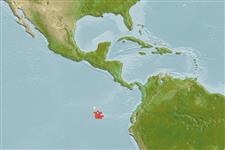Environment: milieu / climate zone / depth range / distribution range
Ökologie
seewasser demersal; tiefenbereich 5 - 73 m (Ref. 11295), usually 15 - 40 m (Ref. 11295). Tropical; 6°N - 3°S, 93°W - 85°W (Ref. 5222)
Eastern Pacific: Isla del Coco off Costa Rica and Galapagos Islands (Ecuador). Reports from Panama and Peru have been discounted (Ref. 6873).
Length at first maturity / Size / Gewicht / Alter
Maturity: Lm 65.3 range ? - ? cm
Max length : 120 cm TL Männchen/unbestimmt; (Ref. 5222)
Rückenflossenstacheln (insgesamt) : 11; Rückenflossenweichstrahlen (insgesamt) : 16 - 17; Afterflossenstacheln: 3; Afterflossenweichstrahlen: 11. Distinguished by the following characteristics: dark to olive-brown body color with purplish and lighter brown spots, or plain dark brown; xanthic morph is bright yellow all over; depth of body contained 2.9-3.2 times in SL; head length 2.6-2.9 times in SL; slightly convex interorbital area; angular preopercle, with serrate lobe at angle; posterior nostrils of adults much larger than anterior ones (Ref. 89707).
Found among rock walls, underwater lava ridges, and all kinds of well structured vertical rock formations (Ref. 11295). Juveniles found in shallow sandy lagoons (Ref. 5222), also in seagrass beds, mangrove lagoons, shallow lava reefs and inland lava ponds (Ref. 11295). Adults are mainly piscivorous, prey size increasing with predator size (Ref. 11295).
Life cycle and mating behavior
Maturities | Fortpflanzung | Spawnings | Egg(s) | Fecundities | Larven
Heemstra, P.C. and J.E. Randall, 1993. FAO Species Catalogue. Vol. 16. Groupers of the world (family Serranidae, subfamily Epinephelinae). An annotated and illustrated catalogue of the grouper, rockcod, hind, coral grouper and lyretail species known to date. Rome: FAO. FAO Fish. Synop. 125(16):382 p. (Ref. 5222)
IUCN Rote Liste Status (Ref. 130435)
Bedrohung für Menschen
Harmless
Nutzung durch Menschen
Fischereien: kommerziell
Tools
Zusatzinformationen
Download XML
Internet Quellen
Estimates based on models
Preferred temperature (Ref.
123201): 14.5 - 23.7, mean 19.3 °C (based on 4 cells).
Phylogenetic diversity index (Ref.
82804): PD
50 = 0.5000 [Uniqueness, from 0.5 = low to 2.0 = high].
Bayesian length-weight: a=0.00603 (0.00365 - 0.00994), b=3.02 (2.88 - 3.16), in cm total length, based on LWR estimates for this species & Genus-body shape (Ref.
93245).
Trophic level (Ref.
69278): 4.5 ±0.80 se; based on food items.
Widerstandsfähigkeit (Ref.
120179): mittel, Verdopplung der Population dauert 1,4 - 4,4 Jahre. (K=0.18; tm=3; tmax=7).
Fishing Vulnerability (Ref.
59153): High vulnerability (61 of 100).
Nutrients (Ref.
124155): Calcium = 63.5 [28.2, 126.1] mg/100g; Iron = 0.861 [0.465, 1.708] mg/100g; Protein = 18.1 [16.3, 19.8] %; Omega3 = 0.219 [0.129, 0.372] g/100g; Selenium = 66.8 [33.8, 142.8] μg/100g; VitaminA = 23.4 [7.5, 81.7] μg/100g; Zinc = 0.666 [0.455, 0.982] mg/100g (wet weight); based on
nutrient studies.
